deepwordle is a wordle clone game powered by deepgram, textual, tweepy, and friends.
Project description
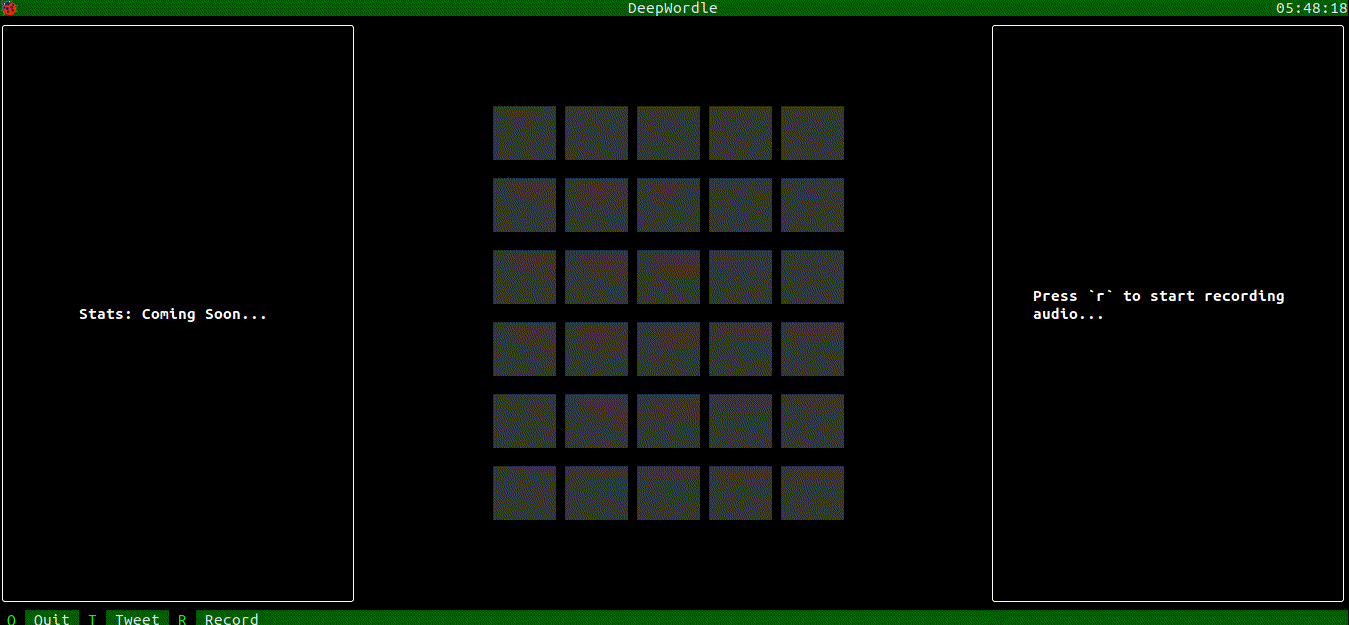
deepwordle is a TUI clone of the famous wordle game powered by Python, Deepgram, Textual, Tweepy, and friends.
1. Configurations
1.1. Tweepy:
1.1.1. Twitter Developer Account:
Create an account on https://developer.twitter.com/, and click on Sign Up

Fill out the required information and submit your request.
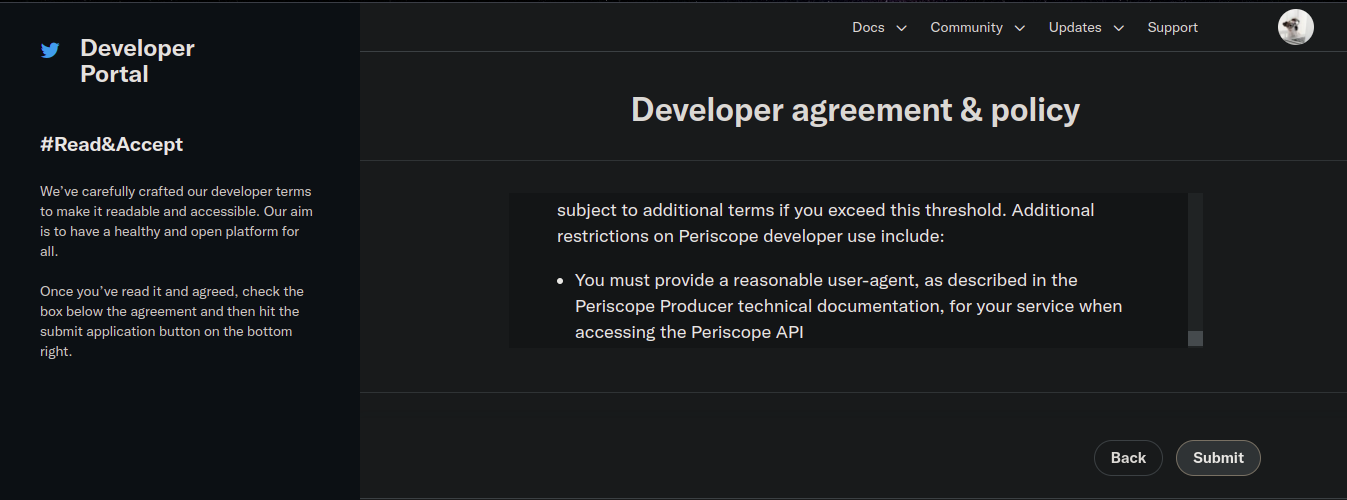
Once approved, you can continue with the app setup.
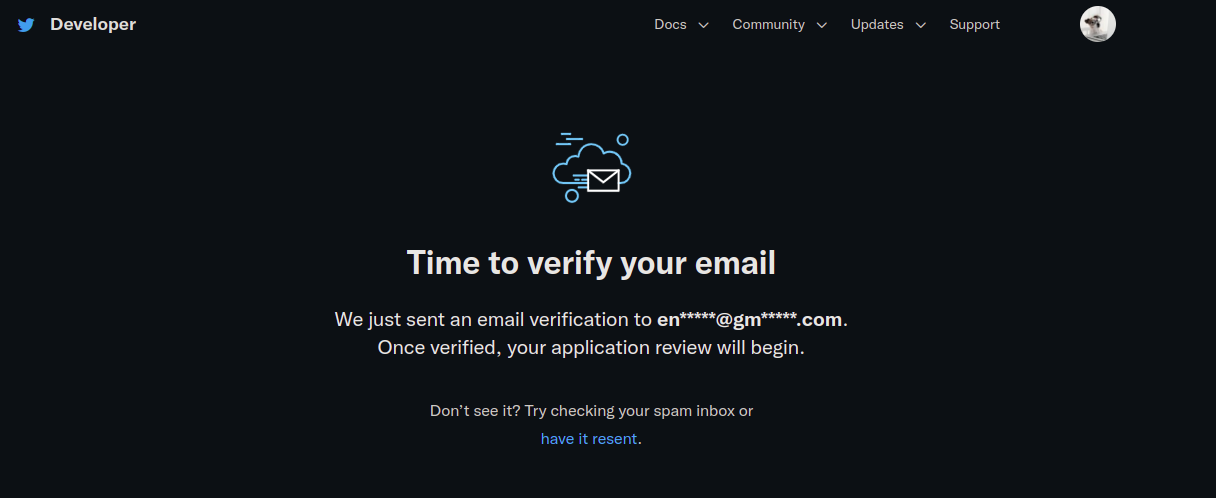
Note that you need to provide detailed information about your use case for the API in order to speed up the process of reviewing your request.
1.1.2. Create an App:
Once your request gets approved, you will be prompted to create an app as shown in the image below:
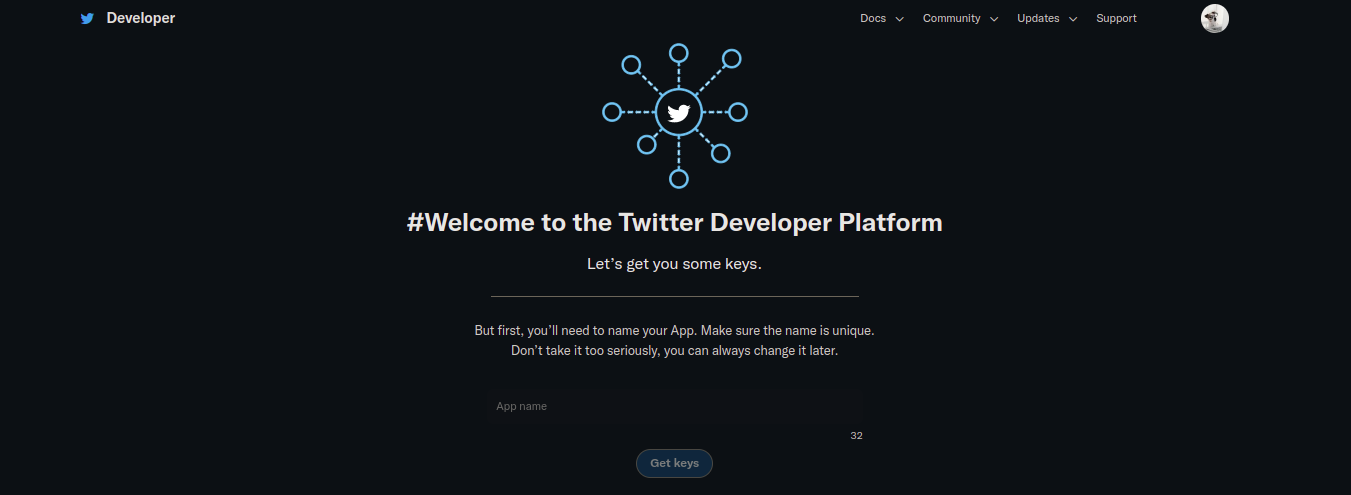
Alternatively, you can go to: https://developer.twitter.com/en
click on the developer portal panel. By doing so, you will be redirected to your dashboard.
Navigate to the Projects & Apps –> Overview, Scroll to the bottom of the page and click on Create App.

Choose an app name and click Complete. By default, the app will be created in read-only mode.

Add write permissions to the app in order to be able to publish tweets. Navigate to App Settings and scroll down to User authentication settings, then click set up.
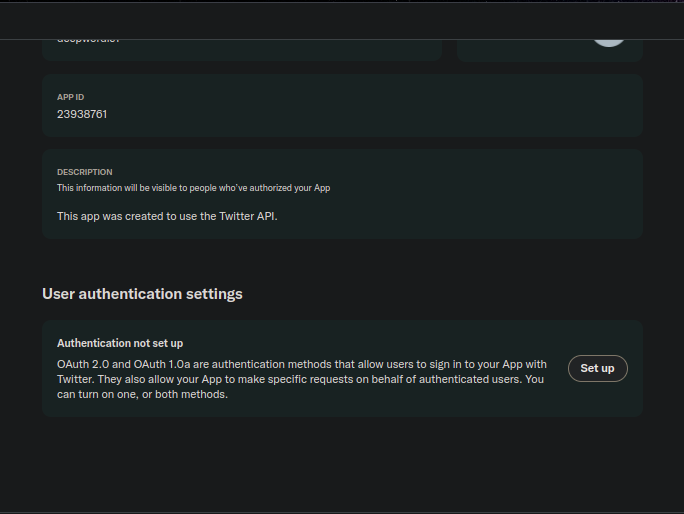
Toggle the OAuth 1.0a button and change app permissions to Read and Write.
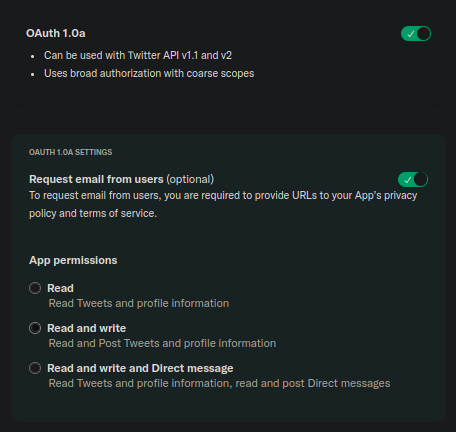
Now your app will get its permissions elevated to Read and Write.
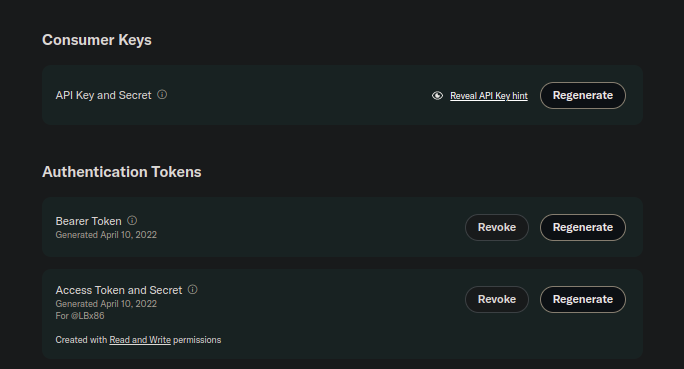
Each app is associated with three sets of keys: an API Key, an API Key Secret, and a Bearer Token.
1.1.3. Store secrets:
You need to store keys and secrets of the app as environment variables in order to authenticate and publish tweets. To do so, open your terminal, and type the following(change each XXXXXXXXXX value accordingly):
export CONSUMER_KEY="XXXXXXXXXX"
export CONSUMER_SECRET="XXXXXXXXXX"
export ACCESS_TOKEN="XXXXXXXXXX-XXXXXXXXXX"
export ACCESS_TOKEN_SECRET="XXXXXXXXXX"1.2. Deepgram:
1.2.1. Create an API Key:
In order to interact with the Deepgram API, you need to grab some keys. To do so, follow along the deepgram official docs to create an API Key.
Now, you need to store your API Key as environment variable in order to authenticate and transcribe audio data. To do so, open your terminal, and type the following(change the XXXXXXXXXX value accordingly):
export DEEPGRAM_API_KEY="XXXXXXXXXX"2. Requirements
2.1. Python Interpreter:
deepwordle was tested and built with Python 3.10.1.
To install Python 3.10.1, I recommend using pyenv.
git clone https://github.com/pyenv/pyenv ~/.pyenvConfigure pyenv on zsh:
cat << EOF >> ~/.zshrc
# pyenv config
export PATH="${HOME}/.pyenv/bin:${PATH}"
export PYENV_ROOT="${HOME}/.pyenv"
eval "$(pyenv init -)"
EOFOr if you are using the default bash shell, run the following command instead:
cat << EOF >> ~/.bashrc
# pyenv config
export PATH="${HOME}/.pyenv/bin:${PATH}"
export PYENV_ROOT="${HOME}/.pyenv"
eval "$(pyenv init -)"
EOFClose your terminal and open a new shell session. Now, you can install Python3.10.1.
pyenv install 3.10.1Make the interpreter available globally:
pyenv global system 3.10.12.2. Virtual Environment:
To manage and set up Python 3.10.1 in a virtual environment, I recommend using poetry.
You can install poetry by running the following command:
curl -sSL https://install.python-poetry.org | python3 -To test if everything was installed correctly, run the following:
poetry env use 3.10.1However, if you are using virtualenv installed via apt, you are most likely to run into the following:
Creating virtualenv deepwordle-dxc671ba-py3.10 in ~/.cache/pypoetry/virtualenvs
ModuleNotFoundError
No module named 'virtualenv.seed.via_app_data'
at <frozen importlib._bootstrap>:973 in _find_and_load_unlockedTo resolve this issue, you need to reinstall virtualenv through pip:
sudo apt remove --purge python3-virtualenv virtualenv
python3 -m pip install -U virtualenvHaving virtualenv set up, you can use poetry to create a new project along with a virtual environment:
poetry new deepwordle && cd deeepwordleNow, you need to let poetry know which version of python to run:
poetry env use 3.10.1Then, you can create and activate a virtual environment to use for this project:
poetry shellNow, at any point in the future, you want to use a virtual environment created by poetry, you can look up
for installed virtual environments under ~/.cache/pypoetry/virtualenvs:
ls ~/.cache/pypoetry/virtualenvsTo activate a virtual environment, run the following:
source ~/.cache/pypoetry/virtualenvs/<your_virtual_environment_name>/bin/activate2.3. PortAudio:
deepwordle depends on PyAudio which in turn depends on another library called portaudio.
To install portaudio on Linux, run the following:
sudo apt-get install portaudio19-dev3. Installation
deepwordle is currently available for Linux os. There are two main methods you can use to install and run the game
With pip:
python3 -m pip install deepwordleWith pipx:
python3 -m pip install --user pipx
pipx install --python python3 deepwordlepipx will install and run deepwordle in your terminal, kind of similar to npx if you are familiar with it.
3. Quickstart
Having deepwordle installed on your machine, you can run it as a CLI from your terminal:
deepwordleor you can use poetry to run the game:
poetry run deepwordle4. Components Overview
There are four main textual components that build up this game:
rich_text: a module to create customized text with different fonts and sizes.
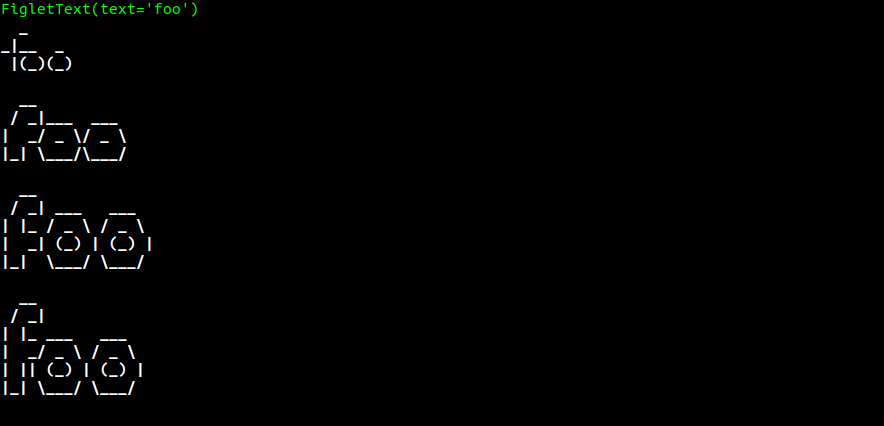
message: a widget to display rich text within a textual panel.

letter: a module to build customized buttons with different fonts, sizes, and styles.
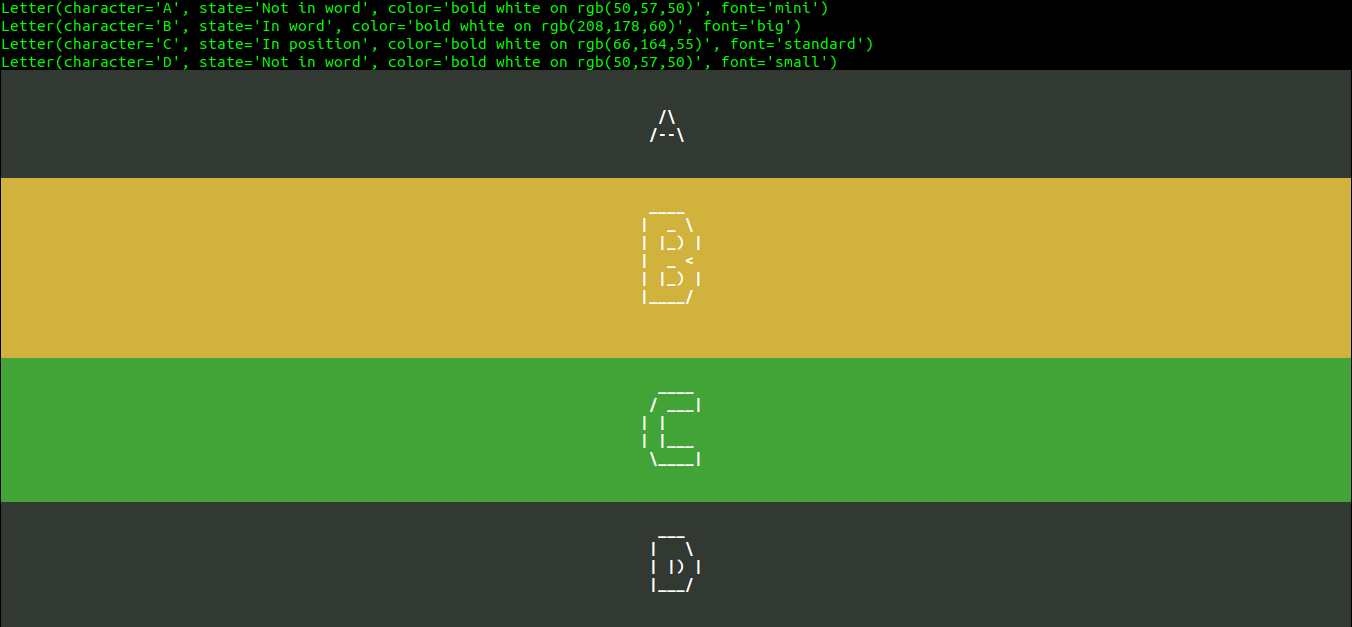
letters_grid: the main letters grid of the wordle game.

5. Game Workflow
a- Enter the game by simply typing deepwordle on your terminal.
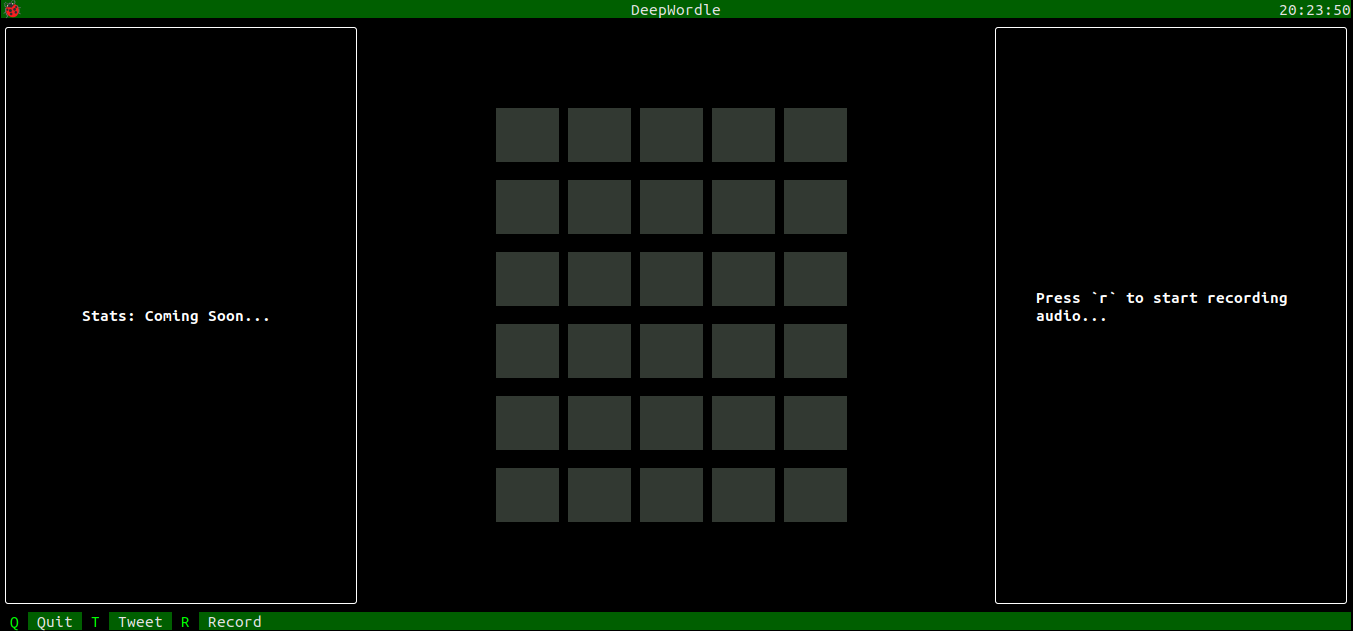
b- Press r to record a word for two seconds.
c- You will be prompted to either submit the word by pressing enter or remove the letters by pressing backspace.
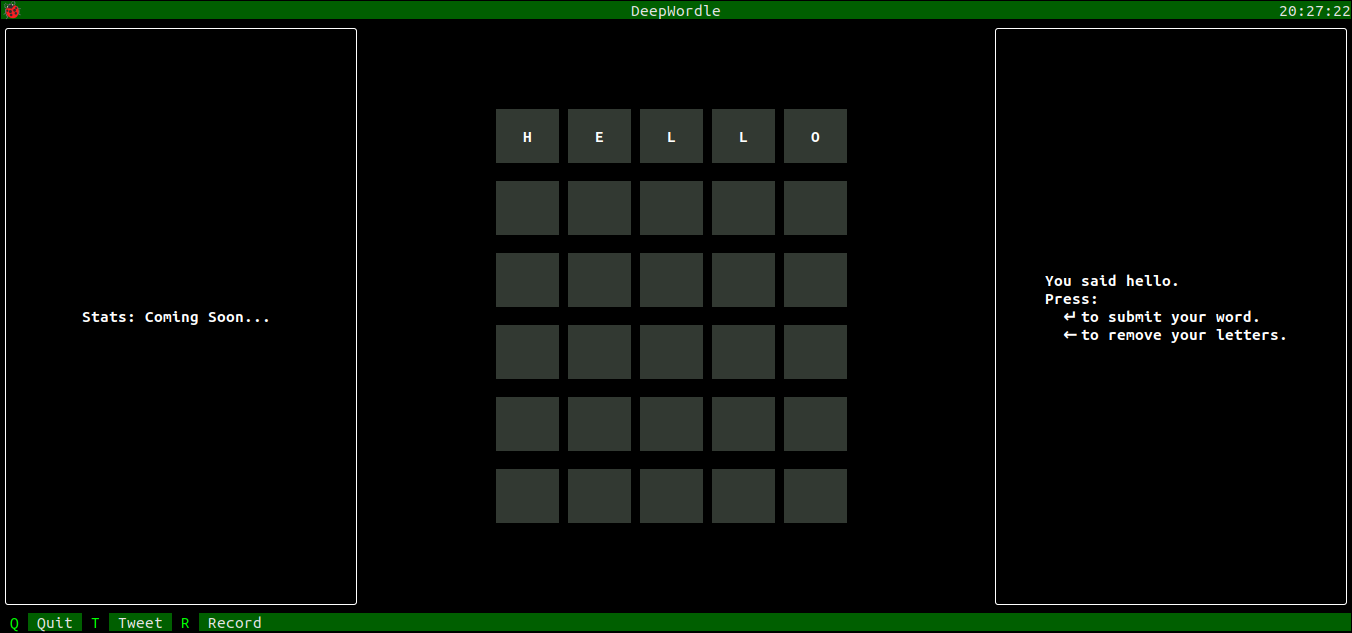
d- Repeat steps b and c until you complete the game.
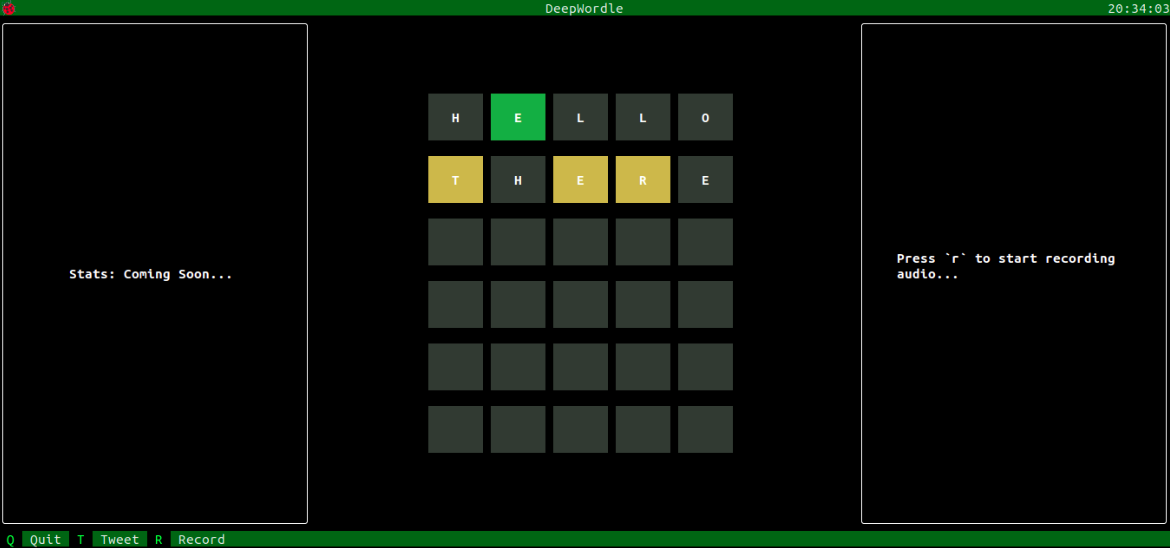
e- If you guessed the secret word, you will be asked to press t to tweet your results.
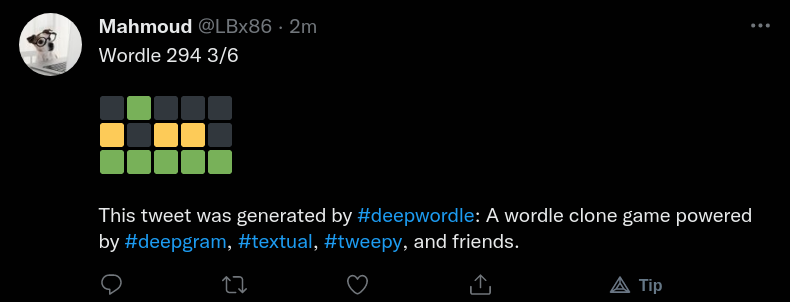
👋 Contribute
If you are looking for a way to contribute to the project, please refer to the Guideline.
📝 License:
MIT licensed. See the bundled licence file for more details.
Project details
Release history Release notifications | RSS feed
Download files
Download the file for your platform. If you're not sure which to choose, learn more about installing packages.
Source Distribution
Built Distribution
File details
Details for the file deepwordle-0.1.0.tar.gz.
File metadata
- Download URL: deepwordle-0.1.0.tar.gz
- Upload date:
- Size: 58.0 kB
- Tags: Source
- Uploaded using Trusted Publishing? No
- Uploaded via: poetry/1.1.13 CPython/3.10.1 Linux/5.13.0-39-generic
File hashes
| Algorithm | Hash digest | |
|---|---|---|
| SHA256 | a7ed427870f173cd90cbcb4743a8198a08d7e41445dbbc1e0c6d430767b9f730 |
|
| MD5 | 0f2ce800cb6a99162404fb7e3576e447 |
|
| BLAKE2b-256 | a9b5cf34b8a87be32d6a898bbdbce178c723b9311583179b96b9efb1b8a4881e |
Provenance
File details
Details for the file deepwordle-0.1.0-py3-none-any.whl.
File metadata
- Download URL: deepwordle-0.1.0-py3-none-any.whl
- Upload date:
- Size: 63.7 kB
- Tags: Python 3
- Uploaded using Trusted Publishing? No
- Uploaded via: poetry/1.1.13 CPython/3.10.1 Linux/5.13.0-39-generic
File hashes
| Algorithm | Hash digest | |
|---|---|---|
| SHA256 | e40b8e05fd979661a5a3f51985c25cddd1052bdd651d1e40b23ac52c405a51f0 |
|
| MD5 | 3ac1a59f817f5b6ddbf87004d014c663 |
|
| BLAKE2b-256 | 415459ef2a916dd7f8cf38a7eddd042a72565994331fdf956ac92b497378d85a |










